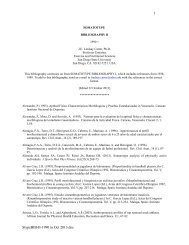THE HEATH-CARTER ANTHROPOMETRIC ... - Somatotype.org
THE HEATH-CARTER ANTHROPOMETRIC ... - Somatotype.org
THE HEATH-CARTER ANTHROPOMETRIC ... - Somatotype.org
Create successful ePaper yourself
Turn your PDF publications into a flip-book with our unique Google optimized e-Paper software.
<strong>Somatotype</strong> Instruction Manual 2<br />
Part 1: The Heath-Carter Anthropometric <strong>Somatotype</strong><br />
- Instruction Manual -<br />
J.E.L. Carter, Ph.D.<br />
Department of Exercise and Nutritional Sciences<br />
San Diego State University<br />
San Diego, CA. 92182-7251. U.S.A.<br />
Introduction<br />
The technique of somatotyping is used to appraise body shape and composition. The<br />
somatotype is defined as the quantification of the present shape and composition of the human body. It<br />
is expressed in a three-number rating representing endomorphy, mesomorphy and ectomorphy<br />
components respectively, always in the same order. Endomorphy is the relative fatness, mesomorphy is<br />
the relative musculo-skeletal robustness, and ectomorphy is the relative linearity or slenderness of a<br />
physique. For example, a 3-5-2 rating is recorded in this manner and is read as three, five, two. These<br />
numbers give the magnitude of each of the three components. Ratings on each component of ½ to 2½<br />
are considered low, 3 to 5 are moderate, 5½ to 7 are high, and 7½ and above are very high (Carter &<br />
Heath, 1990). The rating is phenotypical, based on the concept of geometrical size-dissociation and<br />
applicable to both genders from childhood to old age.<br />
The Heath-Carter method of somatotyping is the most commonly used today. There are three<br />
ways of obtaining the somatotype.<br />
(1) The anthropometric method, in which anthropometry is used to estimate the criterion<br />
somatotype.<br />
(2) The photoscopic method, in which ratings are made from a standardized photograph.<br />
(3) The anthropometric plus photoscopic method, which combines anthropometry and ratings<br />
from a photograph - it is the criterion method.<br />
Because most people do not get the opportunity to become criterion raters using photographs,<br />
the anthropometric method has proven to be the most useful for a wide variety of applications.<br />
Purpose<br />
The purpose of this chapter is to provide a simple description of the anthropometric somatotype<br />
method. It is intended for those who are interested in learning "how to do it". To obtain a fuller<br />
understanding of somatotyping, its uses and limitations, the reader should consult "Somatotyping -<br />
Development and Applications", by Carter and Heath (1990).<br />
Equipment for anthropometry<br />
The Anthropometric <strong>Somatotype</strong> Method<br />
Anthropometric equipment includes a stadiometer or height scale and headboard, weighing<br />
scale, small sliding caliper, a flexible steel or fiberglass tape measure, and a skinfold caliper. The small<br />
sliding caliper is a modification of a standard anthropometric caliper or engineer’s vernier type caliper.<br />
For accurate measuring of biepicondylar breadths the caliper branches must extend to 10 cm and the<br />
tips should be 1.5 cm in diameter (Carter, 1980). Skinfold calipers should have upscale interjaw<br />
3/19/2003




